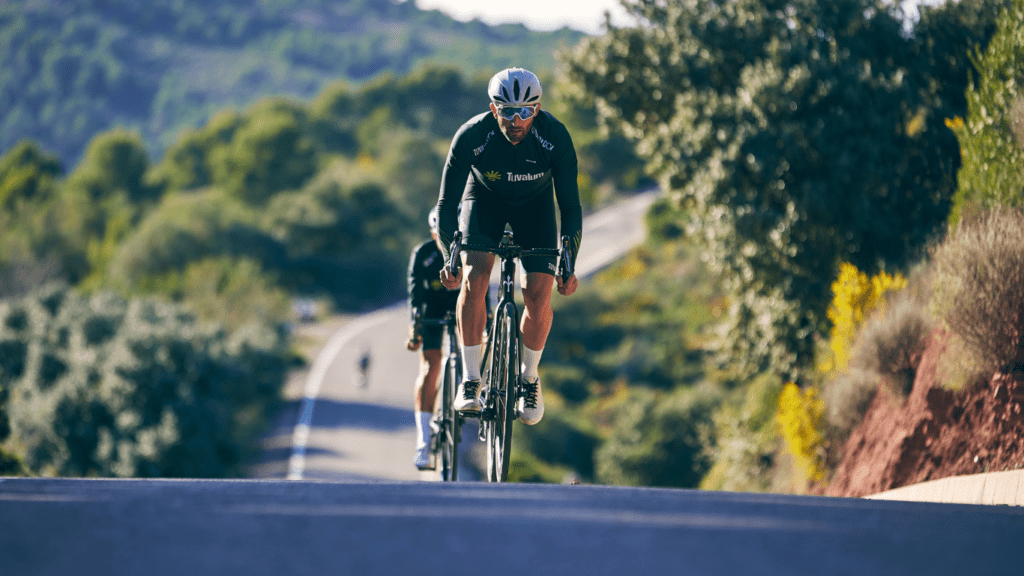The Basics of Training for a Long-Distance Bike Ride
Training for a long-distance bike ride requires planning and dedication. Knowing your goals and having the right gear are critical components.
Understand Your Goals and Timeline
I define specific, measurable goals for my ride. For instance, aiming to complete a 100-mile ride in seven hours. I set a clear timeline to track my progress each week.
This includes gradually increasing my distance and intensity. I adjust my training plan based on my progress and any unforeseen challenges.
Essential Gear for Long-Distance Cycling
I ensure my bike fits me perfectly. A well-fitted bike maximizes comfort and efficiency. I invest in quality cycling clothing, including padded shorts and a moisture-wicking jersey.
Reliable gear such as:
- helmet
- gloves
- sunglasses
is crucial for safety. I carry a repair kit with spare tubes, a pump, and multi-tools to handle any mechanical issues during my ride.
Physical Preparation
Physical preparation is crucial for long-distance bike rides. It ensures the body endures extended periods of cycling without injury.
Building Endurance
Consistency aids in building endurance. Gradually increasing the distance of rides is essential. Start with moderate distances, and incrementally add 10-15% more each week.
For instance, if I start with 30 miles, next week would target 33-35 miles.
Incorporate interval training to boost stamina. Riding at a high intensity for short bursts, followed by moderate-speed cycling, improves cardiovascular fitness.
For example, a regimen could include 5 minutes at a high pace, followed by 5 minutes of moderate riding, repeated several times during a longer ride.
Recovery days prevent overtraining. I ensure to rest or engage in low-impact activities like yoga or swimming. These rest periods help the muscles recover while maintaining flexibility.
Strength Training for Cyclists
Strength training enhances overall performance. Focus on core stability, leg strength, and upper body conditioning. Exercises like planks, squats, and push-ups build necessary muscle groups.
Incorporate compound movements in routine workouts. Squats, lunges, and deadlifts target multiple muscles, increasing overall strength.
For example, doing 3 sets of 10-12 repetitions of each exercise twice a week integrates effectively with cycling training.
Using resistance bands for targeted exercises like glute bridges or clamshells can improve muscle balance and prevent common injuries.
They add resistance without requiring heavy weights, making them ideal for supporting muscles used in cycling.
Maintain a balanced regimen. Combining cycling with strength training creates a strong, resilient body primed for tackling long-distance rides.
Nutrition and Hydration Strategies
To complete a long-distance bike ride successfully, proper nutrition and hydration are crucial. Focus on fueling your body with the right foods and maintaining hydration levels throughout the ride.
What to Eat Before, During, and After Rides
- Before Rides: Consume a balanced meal rich in carbohydrates, lean proteins, and healthy fats 2-3 hours before your ride. Include foods like oatmeal, bananas, vegetables, and chicken breast.
These provide sustained energy and help avoid hunger pangs during the ride. - During Rides: Carry easily digestible snacks high in carbs to replenish energy. Items like energy bars, gels, bananas, and dried fruit work well. Aim to consume 30-60 grams of carbohydrates per hour, adjusting based on intensity and duration.
- After Rides: Post-ride nutrition focuses on recovery. Within 30 minutes of finishing, eat a meal or snack combining carbs and proteins. Examples include chocolate milk, a turkey sandwich, or a smoothie with fruit and protein powder. This aids muscle repair and replenishes glycogen stores.
Importance of Hydration
Proper hydration is key for performance and endurance. Drink water regularly during training to stay ahead of thirst. On long rides, carry two water bottles and drink one every hour, increasing intake if the weather is hot.
To replace electrolytes lost through sweat, include sports drinks or electrolyte tablets. Monitor urine color as a hydration indicator; light yellow signifies proper hydration, while dark yellow suggests dehydration.
Mental Preparation Techniques

Preparing mentally for a long-distance bike ride is just as crucial as physical training. Engaging the mind strengthens commitment and boosts performance.
Setting Realistic Goals
I start by setting attainable goals to stay motivated throughout training. Defining clear, measurable objectives, such as riding a specific distance or time, helps me track progress and see improvements.
Achieving smaller milestones first ensures that my main objective feels within reach. For example, if aiming for a 100-mile ride, I might set interim goals of 20, 40, and 60 miles.
It’s essential to break down the overall target into manageable steps to avoid feeling overwhelmed.
Mental Endurance Tips
Building mental stamina requires consistent practice and resilience. Visualization techniques, where I imagine myself successfully completing the ride, fortify my mental resolve.
During training, I also practice mindfulness, focusing intensely on the present moment to maintain concentration. Positive self-talk, where I affirm my capabilities and remind myself of past achievements, keeps my spirits high.
If I encounter negative thoughts, I reframe them into constructive ones, viewing challenges as opportunities to grow stronger. Engaging in regular mental exercises like meditation enhances my ability to stay calm and focused during the ride.
Cycling Safety and Maintenance Tips
Cycling safely and maintaining your bike are vital aspects of preparing for a long-distance ride. Let’s explore handling road challenges and establishing a bike maintenance routine.
Handling Road Challenges
Navigating obstacles and unpredictable conditions enhances your cycling experience and safety. Stay alert on the road to avoid potholes, debris, and uneven surfaces.
Use proper hand signals for turning and stopping to communicate with motorists and other cyclists. Keep a steady speed in traffic, and always scan your surroundings for any sudden changes.
In rural areas, wildlife and farm equipment often appear unexpectedly. Slow down when approaching rural intersections and always be prepared to stop quickly.
Practice riding in inclement weather, as rain and wind affect visibility and control. Invest in high-visibility gear and lights, especially if riding in low-light conditions.
Bike Maintenance Routine
A consistent maintenance routine ensures longevity and performance. Check tire pressure before each ride to prevent flats and improve efficiency.
Inspect brakes for wear and tear, making adjustments as needed to ensure safe stopping power. Lubricate the chain regularly to reduce friction and prevent rust.
Monthly, examine the entire bike for loose bolts and signs of wear. Clean and oil the drivetrain to maintain smooth gear shifting. Replace worn-out parts, such as brake pads or tires, to avoid issues during the ride.
Keeping your bike in optimal condition not only enhances performance but also ensures safety during long-distance rides.

 I'm Daniel Leverette, and I’m excited to be part of the incredible team at Cycle Smooth Ride Long. Cycling has always been a passion of mine, and now, I get to share that passion with you by bringing expert insights, reviews, and tips to help you elevate your ride.
At Cycle Smooth Ride Long, we believe that every cyclist deserves the best experience, whether you’re hitting the pavement for a casual ride or gearing up for an intense training session. My goal is to ensure that you have the knowledge and tools you need to enjoy every mile, from choosing the right gear to optimizing your nutrition and fitness.
I'm Daniel Leverette, and I’m excited to be part of the incredible team at Cycle Smooth Ride Long. Cycling has always been a passion of mine, and now, I get to share that passion with you by bringing expert insights, reviews, and tips to help you elevate your ride.
At Cycle Smooth Ride Long, we believe that every cyclist deserves the best experience, whether you’re hitting the pavement for a casual ride or gearing up for an intense training session. My goal is to ensure that you have the knowledge and tools you need to enjoy every mile, from choosing the right gear to optimizing your nutrition and fitness.
